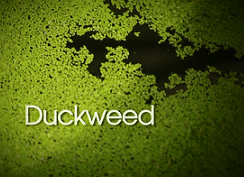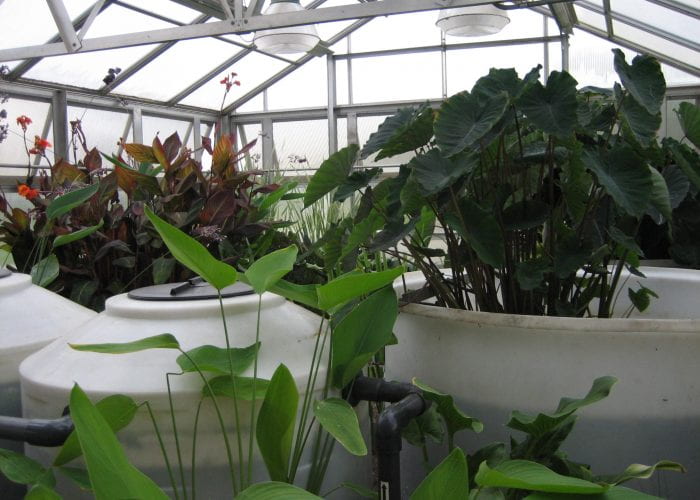The Penn State Eco-Machine™ is a pilot-scale ecological wastewater treatment system. This system operates year-round on municipal wastewater (following rag and grit removal), which is delivered several times per week by our friends at the Penn State Wastewater Treatment Plant. The aim of the research conducted at this facility is to recover valuable nutrients from wastewater and reuse them for the production of fertilizers, feed, and biofuels. We do this with the help of a fabulous little plant called duckweed.
 Duckweed (Lemnaceae), a family of floating, aquatic plants, require only sunlight to treat contaminated water, and simultaneously produce a concentrated source of protein and nutrients. Duckweed may be skimmed from the water, providing a relatively easy means of recovering nutrients from surface waters. Collected duckweed biomass can be upcycled to support sustainable agriculture and the bioeconomy.
Duckweed (Lemnaceae), a family of floating, aquatic plants, require only sunlight to treat contaminated water, and simultaneously produce a concentrated source of protein and nutrients. Duckweed may be skimmed from the water, providing a relatively easy means of recovering nutrients from surface waters. Collected duckweed biomass can be upcycled to support sustainable agriculture and the bioeconomy.
Water-Energy-Food (WEF) Nexus Research at the Eco-Machine
Penn State is committed to sustainability, specifically in creating comprehensive solutions to address the global challenges of providing safe and abundant water, clean and renewable energy sources, and plentiful and nutritious food. The Eco-Machine™ exemplifies this vision of sustainability at the water-energy-food (WEF) nexus, by purifying wastewater and producing plentiful aquatic biomass (like duckweed) which can be used as a soil amendment for growing crops without excess nutrient runoff, as a sustainable protein source for feeding for animals, and as a feedstock for producing biofuels.
Want to learn more about using duckweed for producing sustainable fuels, fertilizers, and food?
Here are some relevant publications on our work related to nutrient recovery and upcycling using duckweed:
**Femeena, P. V.; Costello, C.; and Brennan, R. A. (2023) “Spatial optimization of nutrient recovery from dairy farms to support economically viable load reductions in the Chesapeake Bay Watershed.” Agricultural Systems, 207: 103640. DOI: 10.1016/j.agsy.2023.103640.
**Femeena, P. V.; *Roman, B.; and Brennan, R. A. (2023) “Maximizing duckweed biomass production for food security at low light intensities: experimental results and an enhanced predictive model.” Environmental Challenges, 11: 100709. DOI: 10.1016/j.envc.2023.100709.
**Femeena, P. V.; *House, G. R.; and Brennan, R. A. (2022) “Creating a circular nitrogen bioeconomy in agricultural systems through nutrient recovery and upcycling by microalgae and duckweed: past efforts and future trends.” Transactions of the American Society of Agricultural and Biological Engineers (ASABE) Special Collection: Circular Food and Agricultural Systems, 65 (2): 327-346.
*Calicioglu, O.; Sengul, M. Y.; **Femeena, P. V.; and Brennan, R. A. (2021) “Duckweed growth model for large-scale applications: optimizing harvesting regime and intrinsic growth rate via machine learning to maximize biomass yields.” Journal of Cleaner Production, 324, 15: 129120. DOI: 10.1016/j.jclepro.2021.129120.
*Calicioglu, O.; Femeena, P. V.; Mutel, C.; Sills, D. L.; Richard, T. L.; and Brennan, R. A. (2021) “Techno-economic analysis and life cycle assessment of an integrated wastewater-derived duckweed pond and biorefinery.” ACS Sustainable Chemistry & Engineering, 9: 9395 – 9408. DOI: 10.1021/acssuschemeng.1c02539.
*Fernandez Pulido, C.; ‡Caballero, J. J.; Bruns, M. A.; and Brennan, R. A. (2021) “Recovery of waste nutrients by duckweed for reuse in sustainable agriculture: second-year results of a field pilot study with sorghum.” Ecological Engineering, 168: 106273.
*Roman, B., and Brennan, R. A. (2021) “Life cycle assessment of an Eco-Machine indicates beneficial environmental impacts for upcycling wastewater nutrients into protein-rich duckweed.” Journal of Environmental Management, 288: 112361.
*Calicioglu, A. O., Richard, T. L., and Brennan, R. A. (2019) “Anaerobic bioprocessing of wastewater-derived duckweed: maximizing product yields in a biorefinery value cascade.” Bioresource Technology, 289: 121716.
*Roman, B., and Brennan, R. A. (2019) “A beneficial by-product of ecological wastewater treatment: an evaluation of wastewater-grown duckweed as a protein supplement for sustainable agriculture.” Ecological Engineering X, 1: 100004.
*Kreider, A. N., *Fernandez Pulido, C., Bruns, M. A., and Brennan, R. A. (2019) “Duckweed as an agricultural amendment: nitrogen mineralization, leaching, and sorghum uptake.” Journal of Environmental Quality, 48 (2): 469-475.
*Calicioglu, A. O., *Shreve, M. J., Richard, T. L., and Brennan, R. A. (2018) “Effect of pH and temperature on microbial community structure and carboxylic acid yield during the acidogenic digestion of duckweed.” Biotechnology for Biofuels, 11:275.
*Calicioglu, A. O., and Brennan, R. A. (2018) “Sequential ethanol fermentation and anaerobic digestion increases bioenergy yields from duckweed.” Bioresource Technology, 257: 344-348.
Acknowledgments
This research would not be possible without the work of a dedicated team of undergraduate and graduate students at Penn State, many of whom are featured on this website. We also gratefully acknowledge the class of 2000 and 1950 for gifting the Eco-Machine™ to Penn State, and to our sponsors for funding this work.













 .
. 